Rethinking Ecommerce Loyalty: Innovative Strategies to Increase Customer Retention
In this article, we leverage our expertise in retention marketing to round up seven creative ways to keep your customers coming back for more. Keep reading for strategies, examples and tech recommendations, with advice from our Senior Digital Marketing Manager, Stephen Rowley.
Written By
Hannah Smiddy

As an ecommerce marketer, you’ll be familiar with the benefits of increasing customer retention. Building a base of loyal shoppers who return to your site again and again boosts customer lifetime value, drives revenue, and reduces your customer acquisition costs – ultimately contributing to sustainable business growth.
With more and more brands doubling down on retention marketing, it can feel difficult to cut through the noise and create a customer experience that stands out from your competitors.
Brands need to think creatively about how to surprise, delight and engage customers across all channels. What fun and unique strategies can you use to transform single purchase interactions into meaningful, long-term, profitable customer relationships?
This article is all about rethinking your approach to ecommerce loyalty. It will explore seven innovative ways you can increase customer retention, along with the technology to power these strategies.
7 creative customer retention strategies
1. Build loyal brand communities with a paid membership program
Going a step further than the traditional loyalty program, paid membership programs require customers to pay a participation fee, typically in the form of a one-time membership fee or a recurring subscription. In return, they receive exclusive benefits and opportunities that are only available to members.
Membership benefits could include perks such as free express shipping, ‘always-on’ discount codes, and early access to sales.
“High value personal experiences – like 1:1 consultations with experts – are another type of paid program benefit you might want to consider,” explains Stephen Rowley, Digital Marketing Manager and retention specialist at Swanky.
“For pet brands, this might include a complimentary or discounted private session with a pet nutritionist, or for fashion retailers, you might want to offer exclusive stylist consultations. Benefits like this will help to distinguish your paid membership program from your standard points program, serving as an enticing perk for your customers.”
When executed well, these programs can elevate the customer experience through high-value rewards and exclusive community membership. They can be an effective way to lock in customers and prevent brand switching. In fact, a survey by McKinsey revealed that paid programs can even increase brand affinity compared to free loyalty schemes, with 59% of consumers indicating that they’d be more likely to choose a brand over its competitors since joining a paid loyalty program.
Crucially, the benefits of your paid membership program must outweigh the fees in order to encourage signups. Be sure to clearly demonstrate the perks of becoming a member, majoring on benefits that have a more obvious monetary value, like discounts or free products and services, ahead of experiential benefits where the value is less tangible.
These experiential perks play a role later on in the customer journey, as you work to keep members engaged in your program and encourage retention. Here, you should tap into benefits that emphasise feelings of exclusivity and community, resonating an emotional level with members.
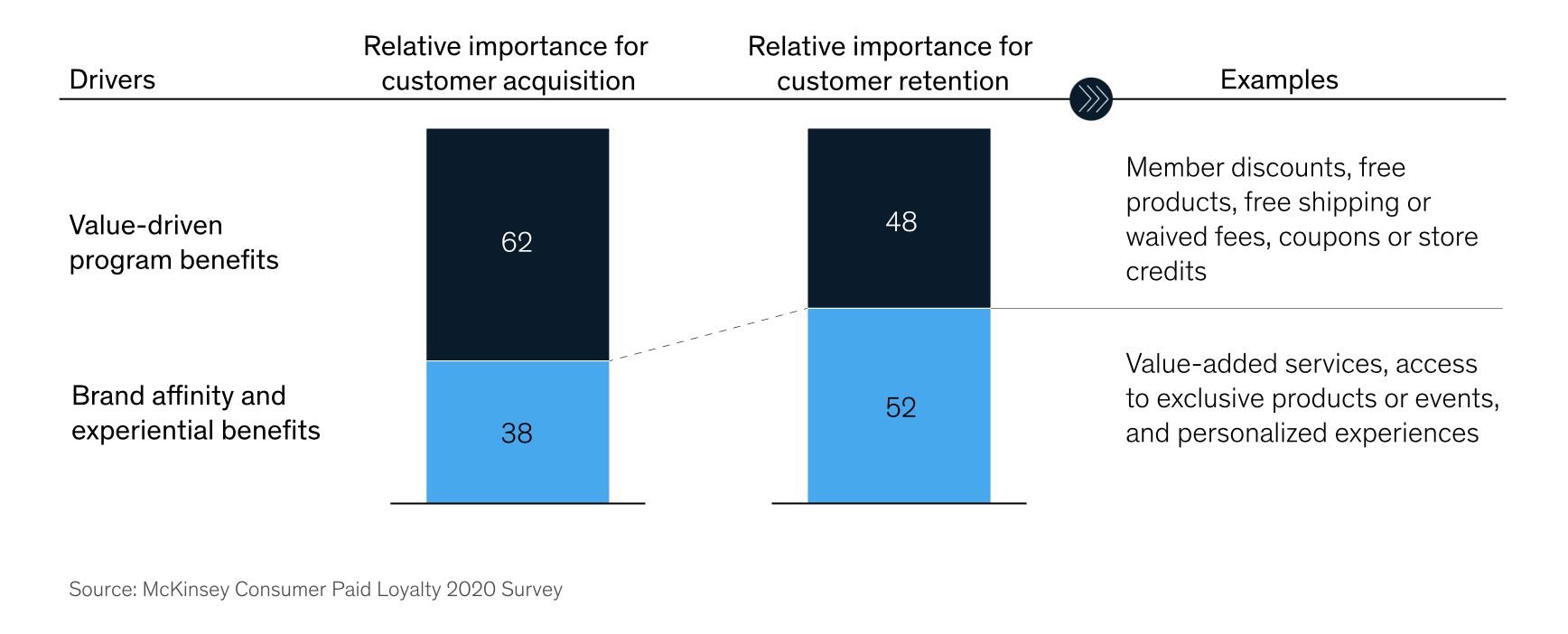
Tech spotlight
Inveterate helps retailers rethink their standard points-based loyalty scheme and build a paid membership program from the ground up. Users can easily implement a paid program on their ecommerce store in a matter of clicks, creating different price points and benefits at each level to encourage program retention.
Brand example
Leading lash extension brand (and Shopify retailer) Lashify uses Inveterate to power its paid membership program, MembershipX. For $150/year, members receive VIP benefits such as discounts, free shipping and early access to product drops – creating a sense of exclusivity that encourages loyalty. Furthermore, they offer members a monthly ‘Lash Cash’ allowance to encourage regular repeat purchases.
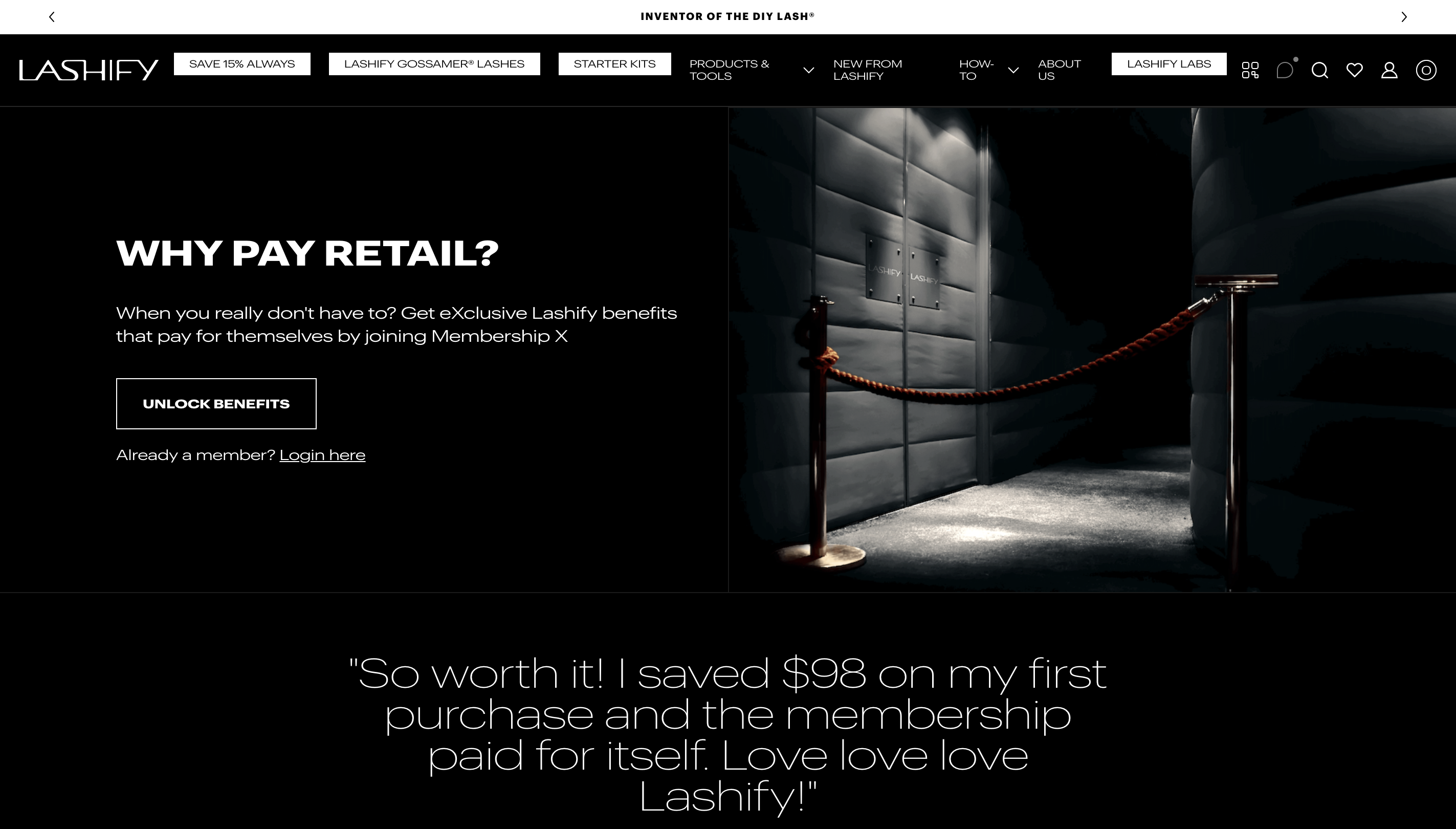
As you can see, the landing page for Lashify’s membership program emphasises the scheme’s VIP nature with the choice of imagery, whilst the text above the fold focuses on the money savings available.
2. Use gamification to engage shoppers and nurture relationships
Ecommerce brands seeking fun and innovative ways to boost customer retention are increasingly looking towards gamification.
By transforming elements of the online shopping experience into rewards-based games and challenges, with opportunities to achieve goals and progress through levels, you can improve engagement with consumers and provide them with motivation to keep shopping with your brand rather than a competitor’s.
Gamification also contributes to a more memorable brand experience thanks to the sense of achievement it provides users. This is important for fostering long-term brand loyalty and retaining more customers.
Ecommerce gamification can vary widely in complexity, with options to suit a range of needs and budgets. Some examples include:
- quizzes that ask simple questions about customers’ preferences and then provide them with personalised product recommendations;
- a tiered ecommerce loyalty program where customers can progress through levels and unlock increasingly appealing rewards as they go;
- ‘spin to win’ or ‘wheel of fortune’ games that offer prizes such as free shipping, limited-time discounts and free gifts;
- mobile app games that reward players who top the leaderboard.
Brand examples
In 2023, beauty giant Sephora launched ‘Beauty Insider Challenges’, a new way for its loyalty program members to earn points through gamification. Challenges included things like buying a product online, collecting an order in-store, signing up for SMS notifications, and using the brand’s shade-matching tool.
This omnichannel loyalty strategy encourages engagement across Sephora’s online and offline channels, whilst driving increased customer retention.
Meanwhile, leading natural hair care brand and Swanky client Bouclème runs a ‘30 Day Challenge’ for new customers. Shoppers are encouraged to complete the on-site quiz to determine their curl profile and then purchase a 30 Day Kit that matches their unique needs.

This is an effective way to introduce new customers to multiple Bouclème products at a time, helping the brand to showcase the benefits of a complete curl care system and encourage retention after the challenge is over. This approach also lends itself well to capturing visual user-generated content (UGC) from customers, which can be leveraged across channels as part of retention campaigns.
You can read more about Bouclème and its journey on Shopify in this ecommerce website design and development case study.
3. Host in-person events to build connections with your VIPs
By creating opportunities for face-to-face connection with your most loyal online shoppers, you can drive further value from this segment – increasing customer retention and transforming them into brand advocates.
There are a number of ways in which in-person events contribute to long-term loyalty and retention:
- They humanise your brand – strengthening brand-consumer connections and fostering trust.
- They help to create and nurture lasting relationships between your staff and customers. It’s these relationships that can distinguish your brand from the competition and help increase sales.
- Events are a chance to showcase a brand’s unique history, values and personality; positively influencing customer perception and again creating stronger emotional connections.
- They make invited customers feel special and valued – making them less likely to switch to another brand.
- These sorts of experiences facilitate community building – creating a sense of belonging which encourages ongoing engagement with a brand.
- In-person events could also be a great place to gather valuable feedback from your loyal customers on what they are looking for from your brand. We discuss this in more detail later on in this article.
With these benefits in mind, why not consider running an invite-only in-person event for your VIPs? This could take the form of a product launch event, a masterclass on a topic in your industry niche, or even a user group session for collecting feedback and brainstorming product improvements.
Brand example
Popular skincare brand Dr Sam’s (another Shopify retailer) leveraged the power of in-person events with its ‘Absolutely Flawless Skin Tour’. Loyalty program members (and their plus-ones) were invited to attend via email.
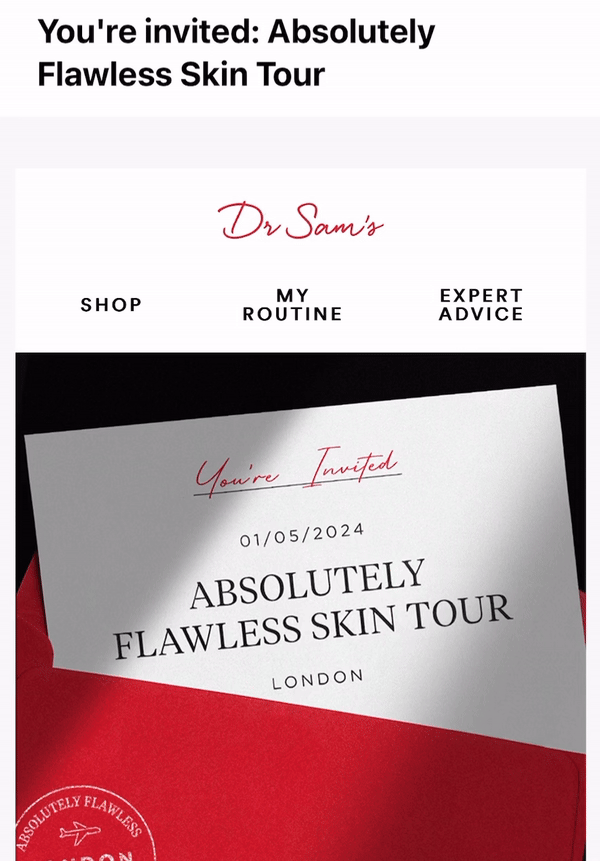
The initial invitation email covered all bases by:
- promoting the educational benefits of attending (“learn expert secrets to glowing skin”);
- illustrating the value that customers will get (“uncover your personalised skincare routine”); and
- creating a sense of VIP (“be part of an exclusive event”, “receive an exclusive goody bag”).
4. Use email marketing to surprise and delight customers
Surprise and delight marketing is all about making your current customers feel great. This sort of strategy allows plenty of room for your marketing team to get creative.
“For true surprise and delight, consider random acts of kindness,” says Stephen.
“Randomly selecting a few lucky customers to receive a reward can go a long way in nurturing long-term loyalty and encouraging shoppers to spread the word about their experience to friends and family.”
Email can be an effective channel for a surprise and delight retention strategy. Here are some automated emails you might want to consider leveraging:
Birthday emails
Make the most of the high click and transaction rates on birthday emails by featuring an exclusive discount code or similarly appealing celebratory treat. Pair this with personalised product recommendations to show just how much you care – and really make your customers smile. Stephen explains this further below:
“Show the recipient that you understand their needs by putting recommendations for products you know they’ll like in front of them. Use information you have about the customer, combined with predictive analytics, to serve up intelligent, targeted suggestions. This can improve email engagement and conversion rate, whilst building meaningful relationships with your shoppers. ”
Jewellery brand Bloom Boutique collects information about customer’s birthdays to send celebratory discount codes via email.
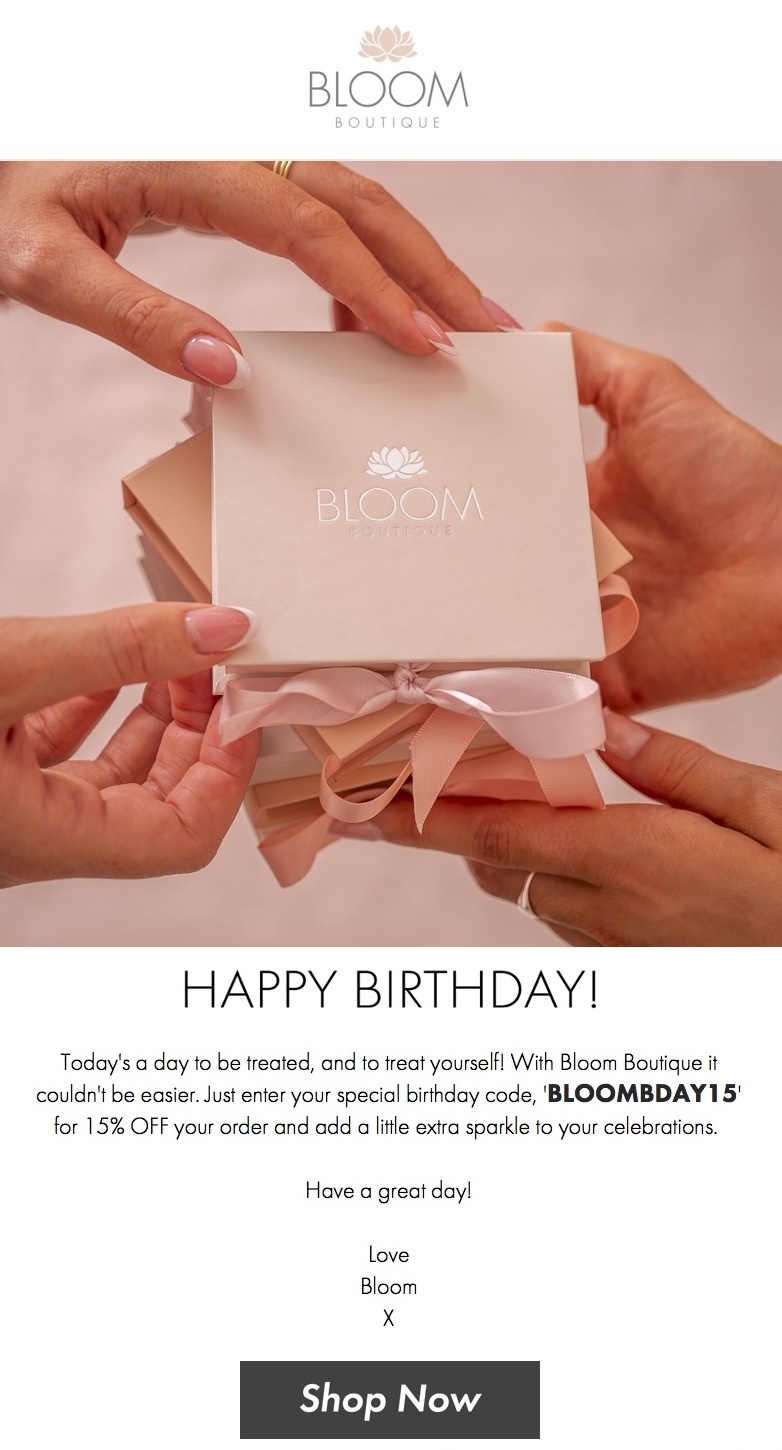
Thank you emails
“A humble thank you email can cut through the noise in a customer’s inbox and make them feel like a valued member of your brand community,” explains Stephen.
Communicating your appreciation in a standalone thank you email is sure to put a smile on customers’ faces. Keeping it free from CTAs is a nice touch that can help distinguish your brand from competitors.
Surprise gift emails
Sending an email with a surprise gift – like a discount code, free shipping or gift card – makes customers feel appreciated by your brand, and will often lead directly to a purchase being made.
Anniversary emails
We’ve touched on automated birthday emails, but there are other dates you can celebrate with your customers as part of a surprise and delight strategy. More generally, these include anniversaries of your customer’s first purchase, or the date they joined your loyalty program.
Depending on your business, it might make sense to recognise other special occasions too – like wedding anniversaries if your audience includes brides and grooms. These sorts of anniversary emails can be a great way to keep your customers engaged and show how much you care about them.
Tech spotlight
Popular marketing automation platform Klaviyo makes it easy to set up and automate surprise and delight emails using triggers and flows. It uses integrated AI and predictive analytics to enhance emails with intelligence, allowing retailers to create high-conversion emails at scale. Find out more about our Klaviyo managed service to get the best out of email automation.
5. Hyper-personalise your omnichannel brand experience
When it comes to elevating your loyalty strategy, there are sophisticated tools you can use to go beyond traditional personalisation, instead hyper-personalising the retail experience across channels and touchpoints.
Hyper-personalisation in ecommerce involves the use of artificial intelligence (AI) and real-time data to provide highly curated products, content and messaging to shoppers.
But how does hyper-personalisation increase customer retention?
- Demonstrating a deep understanding of a customer’s needs creates a more relevant and satisfying shopping experience that makes customers feel seen, heard and valued. This enables brands to build more meaningful, long-lasting relationships with customers.
- Intricately tailored communications and content are more likely to capture consumers’ attention and contribute to a memorable brand interaction – encouraging satisfied shoppers to keep coming back for more.
- Presenting customers with hyper-personalised recommendations can streamline the product discovery process, as well as the path to checkout. A fast and frictionless experience like this can encourage repeat purchases.
Tech spotlight
Dynamic Yield by Mastercard enables brands to personalise every interaction at a highly granular level. Retailers can use the platform’s powerful suite of features to deliver an optimal customer experience at scale across web, mobile, email and ads. From tailoring the static content of a page to suit an individual user, to even changing how content is arranged on a page according to a visitor’s preferences, Dynamic Yield provides a full menu of hyper-personalisation functionality.
As well as standalone tools like Dynamic Yield, there are also integrations that can enable hyper-personalisation, as Stephen explains:
“Consider how you can create deeper insights – and therefore provide more targeted experiences – by pulling together data from multiple sources. For example, the Klaviyo/Meta integration enables marketers to leverage Klaviyo data to refine ad audiences and provide specific and relevant content for these users.”
6. Centre a marketing campaign around UGC
UGC is a powerful form of social proof. It not only supports conversion efforts (by building trust amongst potential new customers), it can be an effective part of your retention strategy too.
Running a marketing campaign around UGC fosters a sense of community and immerses your existing customers into your brand. This is important for cultivating loyalty and encouraging brand advocacy.
Here are some UGC campaign ideas to consider:
- A brand ambassador search, where your most valuable customers are encouraged to submit photos, videos or other creative content sharing their experiences with your products or how they embody what your brand is all about.
- Weekly, product-focused social media ‘takeovers’, where you select and post your favourite UGC showing how customers use your products. For home and garden ecommerce brands, this might be content from your customers showing how they style a particular item. Or for beauty and cosmetics retailers, this could be UGC showing makeup or hair looks that shoppers have created with your products. For customers, being selected to appear on your channels will strengthen their emotional connection with your brand, laying the foundations for long-term loyalty.
- A lookbook hosted on your ecommerce store’s blog, featuring your team’s top UGC picks.
Tech spotlight
When it comes to tools that can help you collect and showcase UGC, two Swanky favourites are customer marketing solution Okendo and ecommerce retention marketing platform Yotpo.
Brand example
Luxury womenswear brand and long-term Swanky client Needle & Thread has an ongoing UGC campaign around customer celebrations. Customers are encouraged to share images of themselves wearing the brand at special events using a dedicated hashtag. These photos are then showcased on a page on Needle & Thread’s ecommerce site.
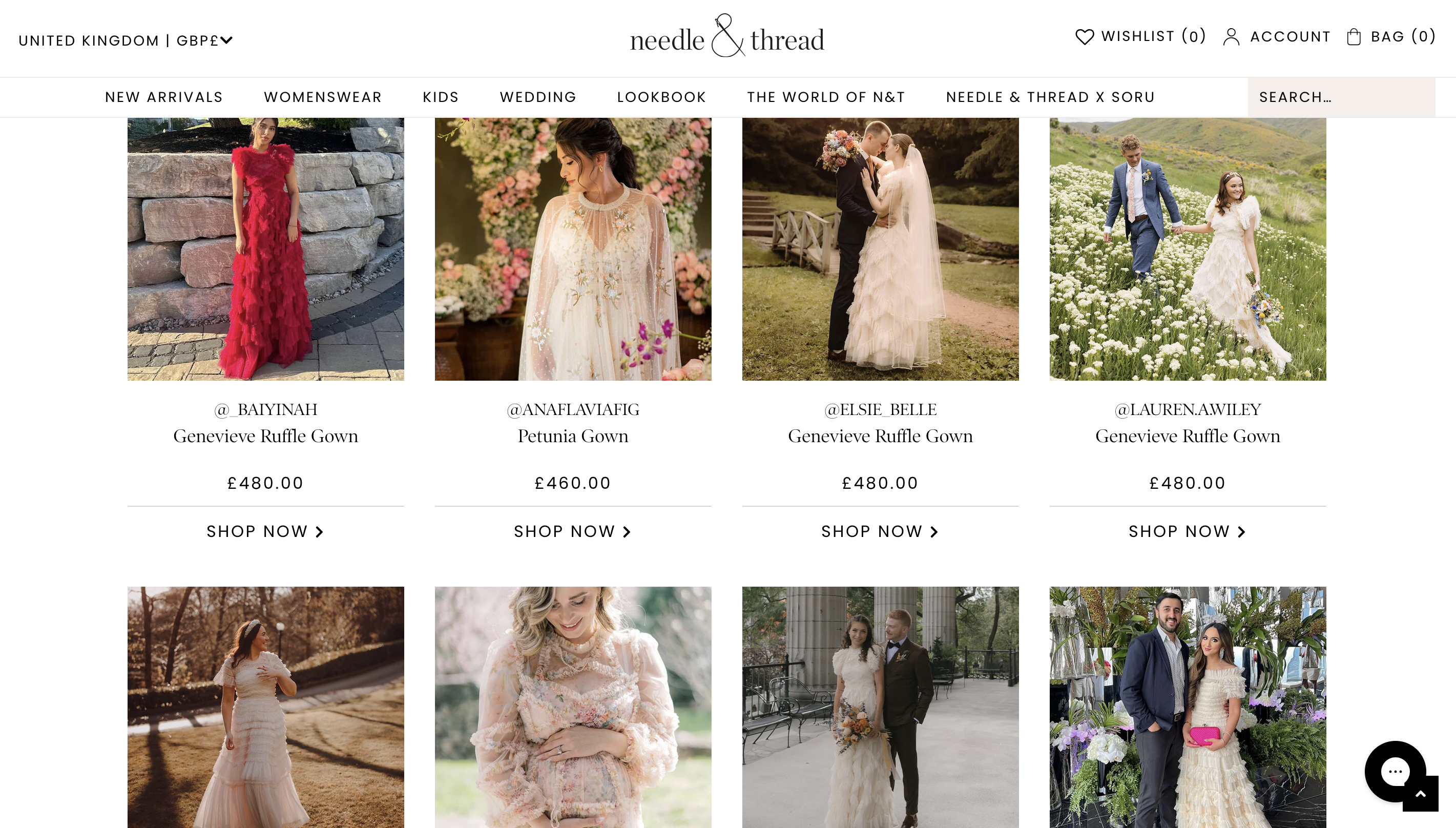
7. Don’t forget the power of asking for customer feedback
This final tactic is all too often overlooked by ecommerce marketers when considering retention strategies, but engaging with your brand community, listening to your customers, and acting on their feedback can be a powerful way to increase customer retention.
Being listened to makes shoppers feel understood and appreciated. Seeing evidence that you’ve taken their comments on board and incorporated them meaningfully across your business further increases this sense of value and belonging. With this, comes the sort of strong customer-company connections that foster long-term loyalty to your brand.
When it comes to asking for feedback, on-site and email surveys are relatively inexpensive and straightforward to implement. Meanwhile, there’s lots to be learned from mining reviews, social media posts and customer service tickets.
For brands thinking a little more creatively (and with bigger budgets) though, here are some other, more experiential, options for listening to customers:
- You could invite a select group of your most valued customers to join a regular focus group where they share in-depth insights about their experience with your brand. This could be a series of virtual sessions or in-person gatherings.
- Consider setting up a physical pop-up location where customers can provide feedback in-person. You could incentivise participation with free samples, discount codes or new products to test out.
- Embrace immersive technology like virtual reality (VR) and allow customers to interact with virtual prototypes of your product before providing feedback. This can offer your ecommerce team valuable insights into user preferences, whilst engaging shoppers in a fun and interactive customer listening exercise.
Brand example
Swanky client The British Blanket Company leveraged this customer retention strategy, creating an exclusive Design Club that allowed loyal customers to get involved in choosing the designs of new product ranges. Design Club newsletter recipients would get a sneak peek of forthcoming designs, as well as the chance to have their say on which designs should be selected. They were also given VIP access to pre-sales discounts.
Being part of the design process like this makes customers more likely to want to purchase the resulting products, since they feel a sense of ownership. It also makes them feel more valued and included, contributing to increased retention and brand loyalty.
The importance of an omnichannel retention strategy
Ultimately, whichever tactics you employ as part of your customer retention strategy, it’s crucial to take an omnichannel approach.
“With siloed retention efforts, you’ll struggle to compete with others in your market who are working to boost loyalty across touchpoints and channels,” explains retention expert Stephen.
“Instead, consider how you can engage your existing customers with an integrated, consistent retention strategy that nurtures long-term relationships across your online store, social media, mobile app, email, SMS, physical locations and any other relevant channels.”
Could Swanky help increase customer retention for your brand?
Our Growth Accelerator team is made up of specialists in ecommerce strategy, digital marketing and data analytics – a winning combination when it comes to planning, implementing and optimising customer retention strategies.
To find out more about how we can help you nurture ecommerce loyalty and increase customer retention, contact our team today.

